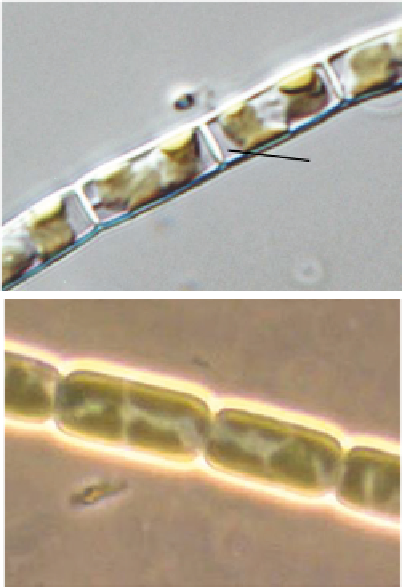Environmental Engineering Reference
In-Depth Information
50 μm
C
h
10 μm
100 μm
10 μm
Figure 4.19
Ulothrix
. Top: Detail from filament show-
ing chloroplast (C) with distinct pyrenoids, wrapping
around the inside of the cell. Reproduced with permis-
sion from R. Matthews. Bottom: General view of floating
mass of filaments, separate sample.
Figure 4.18
Tribonema.
Top: Detail from filament,
showing curved discoid chloroplasts and 'H-piece'
end walls (h). Reproduced with permission from R.
Matthews. Bottom: Phase-contrast image showing nar-
rowing at cross walls, giving cells a 'barrel shape.' Sep-
arate species.
Ulothrix
species are composed of
unbranched filaments. Cells are cylin-
drical either longer or shorter than broad
depending upon the species, which also
vary in cell wall thickness. There is a single
annular or saddle-shaped chloroplast (some-
times lobed) with one or more pyrenoids.
Commonly forms bright green floating
masses in shallow waters particularly at
cooler times of the year. It can also be
attached to submerged stones or wood or
even on damp soil. Common species include
U. zonata
(cells 11-37 μm wide, usually
shorter than broad, with fairly thick walls)
and
U. aequalis
(cells 13-15 μm wide,
18-30 μm long). Can cause filter blocking
in water treatment works. Chlorophyta.
Plate VI. Fig. 4.19.
Tribonema
forms unbranched filaments. The
cell walls are composed of H-pieces (com-
pare with
Microspora
, which it can be dis-
tinguished from as it does not store starch).
The presence of these H-pieces is best seen
at the broken end of a filament, as they are
not easily visible within the intact filament.
Common in the phytoplankton of lakes and
reservoirs especially those rich in organic
and humic materials. Can occur at pH levels
of up to 9.0 Xanthophyta. Plate V. Fig. 4.18.
42
(41) (a) Chloroplast saddle-shaped extending
more than half way around the circumfer-
ence of the cell ..................
Ulothrix









Search WWH ::

Custom Search